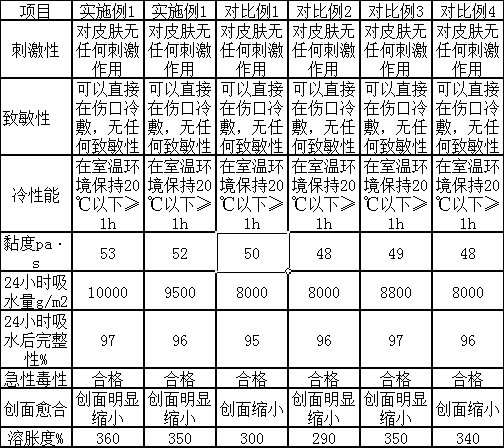Medical cooling polymer hydrogel cold therapy patch
A technology of polymer hydrogel and cold therapy, which is applied in other medical devices, cooling appliances for therapeutic treatment, medical preparations containing active ingredients, etc., can solve the problem of limited cooling range of hydrogel cold therapy patches, etc. Achieve good biodegradability and compatibility, not easy to evaporate, and improve the effect of surface touch
- Summary
- Abstract
- Description
- Claims
- Application Information
AI Technical Summary
Problems solved by technology
Method used
Image
Examples
preparation example Construction
[0028] A kind of medical cooling polymer hydrogel cold therapy paste, its preparation method comprises the following steps:
[0029](1) In a reaction kettle equipped with a reflux condenser, a dropping funnel and a thermometer, add half of the total amount of pure water and picoline, then add selenium dioxide, react at 60°C for 1~2h, and then add dropwise Methane iodide, the reaction kettle and the dropping funnel should be sealed with shading. After 1 hour of reaction, add PVA, silk protein, purple sweet potato powder, and xanthan gum to raise the temperature to 80°C, and stir for 30-60 minutes to obtain mixture A; (2 ) Add half of the total amount of sodium hydroxide, mixture A, polyphosphazene, calcium chloride and sodium tetraborate into the reaction kettle, mix and stir at room temperature, add polyethylene glycol dropwise within 8 minutes, and finish adding dropwise within 6 minutes Polypropylene glycol, then add the remaining sodium hydroxide, the remaining purified wat...
Embodiment 2
[0031] A medical cooling polymer hydrogel cold therapy patch, which is mainly prepared from the following raw materials in parts by weight:
[0032] 13~17 parts of polyphosphazene, 6.3 parts of selenium dioxide, 13 parts of silk protein, 7 parts of purple potato powder, 21 parts of calcium chloride, 9 parts of xanthan gum, 67 parts of purified water, 5 parts of picoline, polyethylene 19 parts of glycol, 2.1 parts of methyl iodide, 8.5 parts of sodium hydroxymethyl cellulose, 33 parts of PVA, 1.3 parts of sodium tetraborate, 1.6 parts of sodium hydroxide, 5.3-8.1 parts of polypropylene glycol, 3.5-5.3 parts of Chinese medicine mixture.
[0033] Further, the polyethylene glycol is PEG-600.
[0034] Further, the degree of polymerization of the PVA is 3500-4000, the degree of alcoholysis is 85-99.7 (mol)%, and the content of -COONa group in the PVA molecule is 0.95-1.2 mol / kg.
[0035] Further, the traditional Chinese medicine mixture is 3.7 parts by weight of borneol, 2.4 parts ...
PUM
| Property | Measurement | Unit |
|---|---|---|
| degree of polymerization | aaaaa | aaaaa |
| alcoholysis degree | aaaaa | aaaaa |
Abstract
Description
Claims
Application Information
 Login to View More
Login to View More - R&D
- Intellectual Property
- Life Sciences
- Materials
- Tech Scout
- Unparalleled Data Quality
- Higher Quality Content
- 60% Fewer Hallucinations
Browse by: Latest US Patents, China's latest patents, Technical Efficacy Thesaurus, Application Domain, Technology Topic, Popular Technical Reports.
© 2025 PatSnap. All rights reserved.Legal|Privacy policy|Modern Slavery Act Transparency Statement|Sitemap|About US| Contact US: help@patsnap.com

